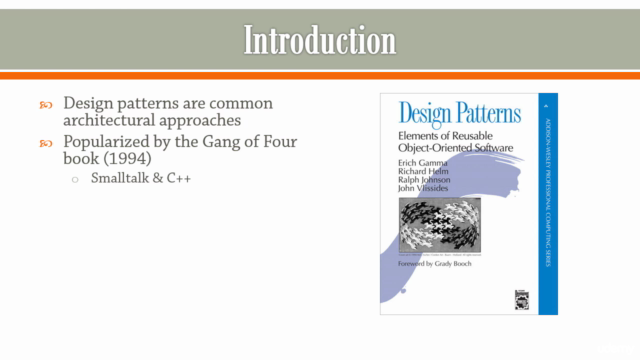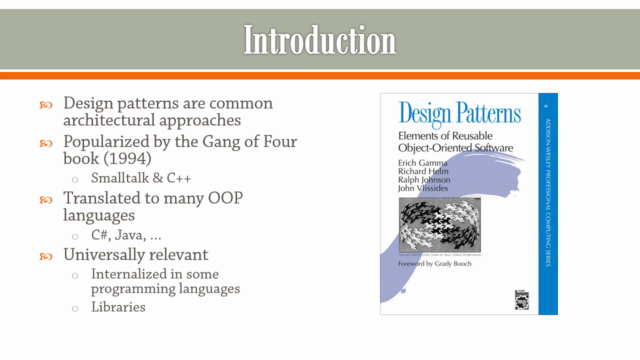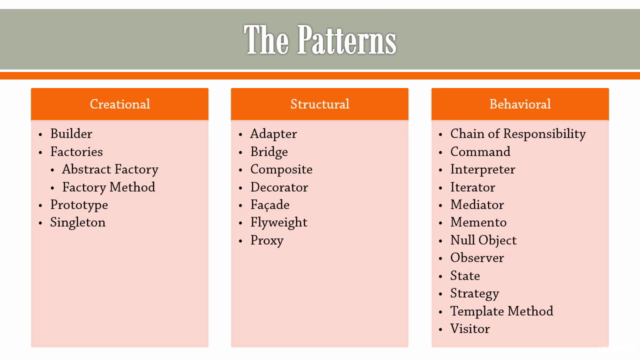Design Patterns in C# and .NET

Why take this course?
🌟 Course Overview: Design Patterns in C# and .NET 🌟
Dive into the world of modern software design with our comprehensive course, "Design Patterns in C# and .NET"! This course is meticulously crafted to offer a practical, hands-on experience with the implementation of design patterns using the latest versions of C# and the .NET framework. We'll explore these concepts through a lens of modern programming approaches, including dependency injection, reactive programming, and utilizing powerful tools like ReSharper.
🔥 Key Features of the Course:
- Latest Technologies: Leverage the latest updates in C# and .NET to implement design patterns effectively.
- Modern Programming Tools: Get hands-on experience with modern developer tools that complement your coding style.
- Deep Dive into Patterns: Discuss variations, alternative approaches, and intrinsic use of patterns within the language itself.
- Gang of Four Design Patterns: A thorough examination of all GoF design patterns, with real-world applications.
📚 What Are Design Patterns?
Design Patterns represent proven, reusable solutions to common software development challenges. The concept was pioneered by the "Gang of Four" (GoF) in their seminal 1994 book, "Design Patterns: Elements of Reusable Object-Oriented Software." Although initially described using C++ and Smalltalk, design patterns have been universally adapted to various programming languages, including C#, Java, PHP, and even non-object-oriented languages like JavaScript.
The timeless appeal of design patterns lies in their ubiquity: they're integral to many libraries and are often embedded within the very fabric of programming languages, influencing your daily coding practices without you even realizing it.
🚀 Patterns Covered
This course meticulously covers all 23 GoF design patterns, ensuring a comprehensive understanding of their applications:
- SOLID Design Principles: Understand and apply the SOLID principles for cleaner, more maintainable code.
- Creational Patterns: Master patterns like Builder, Factories (Factory Method, Abstract Factory), Prototype, and Singleton.
- Structural Patterns: Explore Adapter, Bridge, Composite, Decorator, Façade, Flyweight, and Proxy.
- Behavioral Patterns: Implement Chain of Responsibility, Command, Interpreter, Iterator, Mediator, Memento, Null Object, Observer, State, Strategy, Template Method, and Visitor.
👩💻 Who Is This Course For?
This course is tailored for intermediate to advanced C# and .NET developers who are eager to go beyond the textbook examples and discover the nuanced variations and innovative techniques for implementing design patterns in today's modern software landscape. Whether it's dynamic programming with the DLR (Dynamic Language Runtime) or static implementations, you'll learn how to apply these patterns in real-world scenarios using C# 8 and .NET Core 3.x+.
🎓 Presentation Style
Learn through extensive live demonstrations conducted within Microsoft Visual Studio. The course materials are designed to be immediately applicable, with most demos provided as single-file samples that you can download, run, and experiment with in your preferred IDE, such as Visual Studio, Visual Studio Code, or Rider.
This course eschews traditional UML class diagrams in favor of a more engaging, live coding approach. You'll see real-time implementations and understand the practical implications of design patterns through the use of NuGet packages, R# unit test runner, and even dotMemoryUnit for memory diagnostics.
Join us on this journey to master the art of design patterns in C# and .NET, and elevate your software development skills to new heights! 🚀✨
Course Gallery




Loading charts...
Comidoc Review
Our Verdict
Delving deep into design patterns with C# and .NET, this course offers advanced programmers a wealth of practical knowledge. The high complexity and presentation centered around live-coding may present challenges to less experienced developers; however, the abundance of advanced C# examples offsets these drawbacks.
What We Liked
- In-depth exploration of design patterns in C# and .NET
- High-value course packed with advanced C# aspects
- Real-world examples and practical knowledge for advanced programmers
Potential Drawbacks
- Not suitable for beginners due to high complexity
- Presentation focuses on live-coding without images or diagrams
- Extensive code examples can be challenging